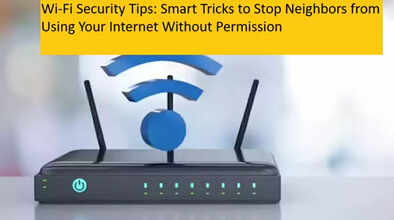Wi-Fi Security Tips: Smart Tricks to Stop Neighbors from Using Your Internet Without Permission

If your Wi-Fi password has leaked into the neighborhood and you’re tired of slow internet because everyone around is connected to your network, it’s time to take action. Many people face this issue—once they install Wi-Fi at home, neighbors or even guests manage to get the password and use it freely. The result? Lower speed, higher data usage, and frustration when you can’t even use your own connection properly.
But the good news is that you can secure your Wi-Fi with a few simple yet powerful tricks. By applying these methods, no one will be able to use your Wi-Fi without your approval. Here’s how you can protect your network effectively.
Step 1: Check How Many Devices Are Connected
The first step is to see which devices are using your Wi-Fi. To do this, log in to your router’s admin panel and check the Connected Devices section. You’ll see a list of all gadgets linked to your network. If you find an unfamiliar device, you can block it instantly from the settings. This helps you monitor unauthorized users in real-time.
Step 2: Use a Strong and Unique Password
If your Wi-Fi password is already leaked, change it immediately. Create a strong password with at least 12 characters, combining uppercase and lowercase letters, numbers, and special symbols like @, #, or *. Avoid using simple passwords such as your name, mobile number, or common phrases, as these are easy to crack. The more complex and unique your password, the safer your Wi-Fi remains.
Step 3: Choose WPA3 or WPA2 Security Protocol
Your router’s encryption method plays a big role in keeping your network secure. Always select WPA3 (or at least WPA2) from the security settings. These encryption standards make it much harder for hackers to break into your Wi-Fi. Avoid outdated protocols like WEP, as they are weak and can be hacked within minutes.
Step 4: Hide Your Wi-Fi SSID
Want to make your Wi-Fi invisible to outsiders? Hide your SSID (network name). You can do this from your router’s settings by enabling “Hide SSID” or “Disable SSID Broadcast.” Once hidden, your Wi-Fi won’t appear in the list of available networks. To connect, you’ll need to manually enter the SSID and password. This makes it harder for strangers to even know your Wi-Fi exists.
Step 5: Enable MAC Address Filtering
Another powerful method is MAC address filtering. Each device (like your phone or laptop) has a unique MAC address. By enabling filtering in your router, only the devices you approve can connect. Add your devices’ MAC addresses to the allowed list, and block all others. This ensures complete control over who uses your Wi-Fi.
Step 6: Create a Guest Network
If relatives, friends, or guests often ask for your Wi-Fi password, don’t share your main one. Instead, create a guest network. This separate connection allows visitors to use the internet without risking the security of your main network. You can also change the guest password frequently, keeping your primary password safe and private.
Final Thoughts
Slow internet caused by neighbors using your Wi-Fi doesn’t have to be your reality. With a few quick settings—like changing passwords, enabling WPA3 security, hiding SSID, or setting up a guest network—you can regain control. Remember, your Wi-Fi is like your digital property, and securing it ensures not only better speed but also protection from potential cyber risks.
By following these simple tricks, you can enjoy fast, secure, and uninterrupted Wi-Fi—without worrying about unwanted users draining your bandwidth.

